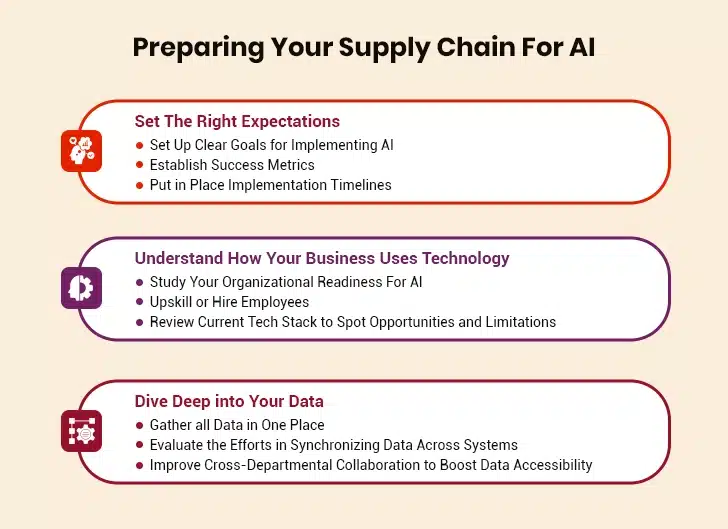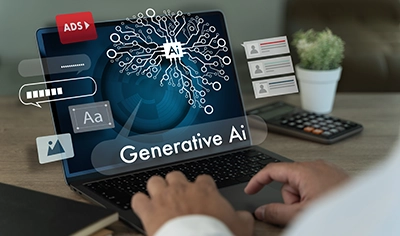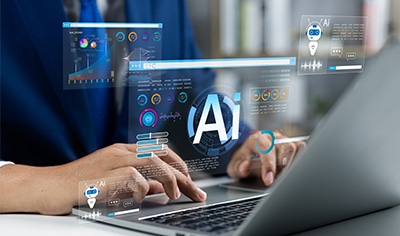Supply chain leaders face a simple choice: adopt AI now or risk falling behind. That’s hardly surprising when you consider how early adopters of this technology have seen dramatic improvements in efficiency and cost savings. Major global players like Walmart, Siemens, and Unilever are already using advanced AI systems to plan for and adapt to the disruptions in supply chains.
AI fits perfectly within the supply chain ecosystem. Today, smart systems can analyze massive datasets, spot potential problems, and suggest real-time solutions. This combination helps businesses recover from longstanding challenges. Companies that refine their supply chains with AI see massive drops in forecasting errors and lost sales.
This blog explores real-world examples of AI implementation in supply chains, the benefits it delivers, and how businesses can effectively measure its impact on their operations. Let’s get started.
Table of Contents
What Is AI in Supply Chain Management?
What Are the Key Benefits of AI for Supply Chain Optimization
Real-World Examples of AI in Supply Chains
How Can Businesses Measure the Impact of AI in Supply Chains
What Does the Future of AI and Supply Chain Management Look Like?
What Is AI in Supply Chain Management?
AI in supply chain management uses advanced computing systems that process huge amounts of data. These systems handle complex tasks and predict trends to help make better supply chain decisions and improve operations. The technology has already gained ground, with MarketsandMarkets noting that AI in the supply chain will reach $50 billion by 2031.
Understanding Artificial Intelligence and Machine Learning in Logistics
Machine learning (ML), a vital subset of AI, lets systems learn from data sets instead of following preset instructions. This ability enables machine learning to surpass the capabilities of regular software. It provides powerful tools to forecast demand, find patterns, predict markets, and analyze complex data.
AI and ML work together in logistics to:
- Study sensor data from equipment to spot possible failures early
- Refine warehouse layouts and inventory management
- Process information from many sources, like transport routes, inventory levels, and customer demand patterns
- Offer guidance on predicting demand and supply
AI systems find patterns and connections in data that humans or standard systems might miss. Some advanced AI systems can even spot new consumer habits and predict seasonal demand with great accuracy.
Why AI Is Becoming Essential in Modern Supply Chains
Today’s unpredictable world puts immense pressure on businesses to boost productivity while cutting down risks. Supply chains have grown more complex, and teams spend a significant amount of time managing them. AI handles these challenges well, which explains why AI-based systems will power most supply chain business operations in the coming years.
Businesses that have already adopted AI-enabled supply chain management report:
- Lower logistics costs
- Better inventory levels
- Improved service levels
- Fewer lost sales
AI does a lot more than just improve operations. It senses demand changes right away. This helps many businesses predict short-term shifts and manage upstream activities better.
Recent global events have shown how uncertainties can shake up supply chains, making contingency planning a necessity. Companies worldwide now use AI to make supply chains transparent, simplify paperwork for physical goods, and process data efficiently.
Generative AI Development for IT Leaders: Implementation and Best Practices
What Are the Key Benefits of AI for Supply Chain Optimization
Companies that use AI for supply chain management secure a competitive advantage through reduced costs and improved business decisions.
1. Improved Forecasting Accuracy
AI-based forecasting is much more accurate than traditional methods, as it studies large, diverse datasets. This includes past sales, market trends, weather patterns, and social media data. Analyzing this information helps businesses predict customer demand with precision. Using AI for forecasting helps their teams avoid errors. This results in more dependable supply chains and reduced waste.
The AI system constantly learns from historical data patterns and keeps improving its predictions. The result? Businesses can foresee shifts in demand, and plan production and inventory better.
2. Reduced Operational Costs and Errors
Implementation of AI systems brings tremendous financial benefits. Companies using AI see much lower logistics costs and better inventory levels. They are also significantly better at meeting customer needs than their competitors, who may be slow to adopt this technology.
AI helps manage stock levels by constantly updating the latest demand information. This prevents the stocking of excess inventory, which ties up money and increases storage expenses. It also avoids stockouts, which generally cause businesses to miss out on sales opportunities.
3. Enhanced Supply Chain Visibility
AI brings unprecedented transparency to complex supply networks. AI systems track and monitor shipments in real time. This helps detect elements that drain productivity and create bottlenecks and delays. This way, companies can find and fix problems before they grow.
Large companies with vast supplier networks use AI-based control towers. These hubs give immediate visibility and control over operations and risks, which is necessary when managing potentially hundreds of suppliers.
4. Faster Decision-Making
Supply chain executives now depend on AI to prevent problems instead of reacting to them when they occur. AI systems use comprehensive data analysis to provide clear, useful insights. These systems crunch information from many sources at once. This dramatically speeds up decisions, especially under pressure.
AI gives warnings about disruptions like shipping delays, unusual routes, or unexpected waiting times. This lets organizations detect risks sooner. They can then act swiftly to fix issues. This builds a much stronger, more nimble supply chain that can recover quickly from problems.
5. Route Optimization and Transportation Efficiency
AI-driven route planning delivers pivotal, immediate improvements to supply chains. These systems study live traffic, weather, delivery schedules, and vehicle capacity to find the best paths for moving goods along the supply chain. They also figure out which shipments should be prioritized based on urgency, customer needs, and product availability.
AI lets vehicles avoid inefficient routes. As a result, they burn less fuel and deliver supplies much faster. This approach helps cut emissions and reduce environmental impact.
Real-World Examples of AI in Supply Chains
Global companies are showing how AI technologies bring measurable value to complex supply chains. These businesses have gained improvements in efficiency, accuracy, and environmental impact using AI.
I. Amazon: Predictive Inventory and Demand Planning
Amazon uses an AI-based demand forecasting model that predicts what products customers want, along with where and when they want them, by studying millions of products daily. Their earlier AI systems only used past sales data. Their new foundation model also includes time-sensitive data like weather patterns and holiday schedules. This helps them place inventory more strategically in the supply chain.
This advanced approach has produced remarkable results. The company has seen 10% improvement in forecasts for deal events and a 20% boost in forecasts for several popular products. The benefits go beyond inventory optimization. Their customers receive packages faster. Their delivery partners drive fewer miles and reduce emissions.
II. Walmart: AI-Driven Customer Demand Forecasting
Walmart uses AI to forecast what people will purchase. Their AI systems study store sales, online orders, local details, and economic trends. This helps predict demand and spot possible problems early. Because of this, Walmart can send products to stores just in time to keep shelves stocked.
Their AI has a granular understanding: it sees tiny differences in demand across neighborhoods. Walmart also uses AI to find the absolute best delivery routes to customers’ homes. This makes deliveries faster and more reliable for customers.
III. Unilever: AI for Improved Production Planning
Unilever has embedded AI throughout its supply chain. Their ice cream division uses AI systems to analyze weather-related data for accurate production planning, since even a 1°C temperature rise can dramatically change demand. This method has improved forecast accuracy by 10% in Sweden.
“Using AI, we now understand where to sell, how much we are going to sell, in which cabinet we are going to sell, and when and where to send our orders in the most efficient way,” Elif Cakir, the division’s head, explains.
The company has also partnered with H2Ok Innovations to clean their food and ice machines using systems based on AI and IoT. The solution helps the client save millions yearly.
IV. Maersk: Enhanced Port Operations Using AI Algorithms
Maersk uses AI digital twins to make port operations smoother. These are virtual copies of real ports that use live data from the actual terminal. Port teams can safely test “what if” situations like sudden traffic jams or worker strikes inside this digital copy. This approach lets them quickly find solutions to plan ship docking, equipment usage, and schedules better.
The digital twin finds efficient solutions fast while replacing slow, manual planning. It turns port preparation from a difficult task into a quick, forward-thinking process. Ships move faster, costs drop, and ports handle problems better.
V. Siemens: Predictive Maintenance with AI
Siemens uses AI-based predictive maintenance solutions to transform traditional equipment upkeep. Manual checking of equipment conditions across large factories can be too complex and time-consuming. To fix the issue, Siemens created AI systems that examine patterns in machine data and suggest maintenance actions before breakdowns happen.
This approach has shown its value at Sachsenmilch Leppersdorf GmbH, a European milk processing plant. Siemens’ solution, Senseye Predictive Maintenance, improved machine maintenance by catching issues early. The system has helped the plant avoid unplanned stops and keep production running smoothly.
Building Smarter Systems: Why AI Development Demands Executive Vision
How Can Businesses Measure the Impact of AI in Supply Chains
AI solutions in supply chain management need specific metrics to measure their performance over time. Companies find it hard to justify investments without proper measurement systems.
1. Key Performance Indicators (KPIs) to Track
Supply chain managers must track the right indicators to measure the performance of AI systems. They should check:
- Forecast Accuracy: AI predictions matched against actual demand show how well algorithms work
- Inventory Turnover: Higher rates show better inventory management through AI
- Order Fulfillment Cycle Time: Shows how much faster orders move from receipt to delivery
- On-Time Delivery Percentage: Shows improvements in delivery reliability
- Warehouse Efficiency: Measures better picking time, inventory accuracy, and space usage
The key is picking the metrics that matter. Too many KPIs create noise. Too few miss important insights.
2. ROI and Cost Savings Analysis
Numbers prove whether AI investments make sense. But measuring AI’s exact returns can be tricky because many benefits of AI are indirect and take time to appear. Selecting the right metrics fixes this. Teams should track:
- Reduction in labor costs
- Decrease in resource usage
- Growth in revenue due to better inventory flow
- New revenue opportunities created by AI
3. Customer Satisfaction and Delivery Metrics
Customer experience metrics show the business impact of AI beyond just operations. Companies can use AI-based sentiment analysis to study customer feedback from different sources. The analysis spots satisfaction levels by checking users’ language, tone, and context. They should also track call and chat containment rates, average handle time, and customer churn. These indicators show how AI makes the customer experience better.
Metrics For Measuring the Impact of AI in Supply Chains
| Measurement Area | Metrics | Purpose |
|---|---|---|
| 1. Operational KPIs | Forecast Accuracy (vs. actual demand) | Measures AI prediction reliability |
| Inventory Turnover Rate | Shows the efficiency of AI-driven inventory management | |
| Order Fulfillment Cycle Time | Tracks speed improvement from order receipt to delivery | |
| On-Time Delivery Percentage | Measures delivery reliability gains | |
| Warehouse Efficiency | Evaluates warehouse optimization | |
| 2. ROI and Cost Savings | Labor Cost Reduction | Tracks automation-based workforce savings |
| Resource Usage Reduction (e.g., fuel, electricity) | Measures conservation of resources | |
| Revenue Growth from Improved Inventory Flow | Links AI-based improvements to sales increases | |
| New Revenue Streams Created by AI | Captures business opportunities produced by AI | |
| 3. Customer Experience | Sentiment Analysis | Evaluates changes in customer satisfaction |
| Call/Chat Containment Rates | Measures self-service resolution effectiveness | |
| Average Handle Time | Tracks the efficiency of AI-supported interactions | |
| Customer Churn Rate | Monitors retention improvements | |
| Customer Satisfaction Scores | Quantifies boost in overall experience |
What Does the Future of AI and Supply Chain Management Look Like?
The rise of AI in the supply chain will reshape how global networks operate. Supply chains will become smarter and solve many longstanding problems. They will adjust easily to unexpected events and disruptions.
I. Autonomous Supply Networks and AI Agents
Autonomous agents mark the next frontier. These systems use artificial intelligence to make decisions without human input. They make complex processes smoother by automating tasks and reducing risks. This way, teams get more time to focus on higher-value activities.
Furthermore, these agents can learn on their own through memory engines. They can communicate in natural language and analyze large amounts of data in real time. Supply chains of tomorrow might use hundreds of specialized AI agents working together to make operations better.
II. Rise of Generative AI in Supply Planning
Generative AI builds stronger data foundations. It pulls useful information from unstructured data and helps predict product demand better. Companies that use technology mindfully can have generative AI as a helpful advisor to build resilient supply chains.
GenAI tools assist with sorting information, checking real-time data, creating content, breaking down large data sets, and giving quick answers. Logistics companies can use them to simulate different supply scenarios and study the effect of possible global disruptions.
III. AI-Driven Sustainability and ESG Reporting
AI-based ESG reporting tools make it easier to collect data, track progress, and follow new sustainability rules. These platforms track ESG metrics and spot sustainability risks throughout the supply chain.
AI analyzes data from suppliers’ environmental impact and management practices to find risks early. The best part is that AI can also combine with Blockchain to track products from source to delivery and verify ethical practices.
IV. Collaboration Between AI, IoT, and Blockchain
AI, IoT, and Blockchain working together create a powerful supply chain system. IoT sensors deliver updates from the physical world in real time. AI responds right away by negotiating delivery dates and keeping inventory levels optimal. Blockchain adds transparency and immutability. It shows clearly where products come from and their carbon footprint. These three technologies together enable complete tracking, better data security, and more reliable sustainability checks. The result is a supply chain that can adapt and respond faster than ever before.
The Final Word
AI is transforming every facet of supply chain management. Businesses now achieve lower operational costs, improved inventory levels, and better service levels using AI solutions.
Industry leaders show how AI creates value. Their applications prove how AI can be used to create substantial advantages. Nevertheless, challenges exist. Companies need a clear plan and measurement framework to succeed with AI implementation.
The future of artificial intelligence and supply chain management looks promising. Autonomous supply networks, generative AI applications, sustainability solutions, and integration with complementary technologies will further boost global supply operations. Companies that thoughtfully implement this technology will see reduced costs, improved visibility, and faster decision-making. Leaders who embrace new ideas now will write the next chapter of the AI story.







